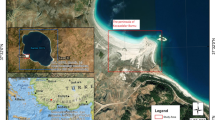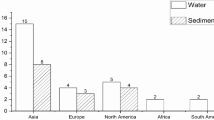Abstract
Humic substances extracted and purified from bottom sediments of northern Lake Biwa, Japan, in November 2012 and 2013 were characterized using elemental analysis, Fourier-transform infrared spectroscopy, hydrogen-1 nuclear magnetic resonance (1H NMR) analysis, and pyrolysis gas chromatography/mass spectrometry (Py-GC/MS). The infrared (IR) bands in the spectra of humic acids showed the presence of amide linkages and polysaccharides. Results of 1H NMR analysis showed that the humic acids contained approximately twice the number of aliphatic protons as those in the Japanese soil standards used for comparison. Results of the Py-GC/MS analysis, which evaluates pyrolysis temperature dependency of the amount of pyrolysis products, showed that the generation of pyrolysis products in humic acids also differed from that in Japanese soil standards but was similar to that of phytoplankton in Lake Biwa. This analysis method is the first to provide extensive information about the chemical structure of humic substances; conventional Py-GC/MS provides limited information for a single temperature. Data suggest that humic acids in lake sediments are related to chemical characteristics of phytoplankton. Results shed new light on the origins of humic substances in deep-water-lake sediments and provide insights into material recycling in such sediments.











Similar content being viewed by others
References
Alen R, Kuoppala E, Oesch P (1996) Formation of the main degradation compound groups from wood and its components during pyrolysis. J Anal Appl Pyrol 36:137–148
Almendros G, Guadalix ME, Gonzalez-Vila FJ, Martin F (1996) Preservation of aliphatic macromolecules in soil humus. Org Geochem 24:651–659
Bracewell JM, Robertson GW, Robertson DI (1980) Polycarboxylic acids as the origin of soil organic matter. J Anal Appl Pyrol 2:239–248
Chiavari G, Galletti GC (1992) Pyrolysis-gas chromatography/mass spectrometry of amino acid. J Anal Appl Pyrol 24:123–137
Endo G (1990) Population dynamics of methanogenic bacteria in lake sediment and estimation of sediment rolling up by sulfate reducing bacteria. Environ Syst Res 18:178–183
Fujitake N, Kodama H, Nagao S, Tsuda K, Yonebayashi K (2009) Chemical properties of aquatic fulvic acids isolated from Lake Biwa, a clear water system in Japan. Humic Subst Res 5:45–53
Hayakawa K (2005) Behavior of the organic matter in Lake Biwa. Lake Biwa Res Inst Bull 22:161–170
Hayakawa K, Okamoto T (2012) New issue–COD increase in the water of Lake Biwa. In: Kawanabe et al. (eds) Lake Biwa: interactions between its nature and people. Springer, Tokyo, pp 437–441
Hayes MHB, MacCarthy P, Malcolm RL (1998) Humic substances II: in search of structure. Wiley, New York
Helen AJ, Hongbo L, Nelson B (2000) Pyrolysis gas chromatography–mass spectrometry of humic substances extracted from Canadian lake sediments. Can J Chem 78:51–63
Ichise S, Fujiwara N, Furuta R, Ikeda S, Kisimoto N (2010) About the longterm variation analysis of the plankton in Lake Biwa. Res Rep Lake Biwa Environ Res Inst 7:196–219
Ishiwatari R (1967) Elementary composition of humic acids from lake sediments. Geochem Soc Jpn 1:7–14
Ishiwatari R (1977) Organic geochemistry of α 200-meter core sample from Lake Biwa. III Isolation and characterization of kerogen and humic acid. Proc Jpn Acad 53B:47–50
Ishiwatari R (2010) Insoluble organic matter in recent sediments: characterization, formation and thermal alteration. Chikyukagaku 44:31–41
Kawahigashi M, Fujitake N, Takahashi T (1996) Structural information obtained from spectral analysis (UV-VIS, IR, 1H NMR) of particle size fractions in two humic acids. Soil Sci Plant Nutr 42:355–360
Kuwatsuka S, Tsutsuki K, Kumada K (1978) Chemical studies of soil humic acids I elementary composition of humic acids. Soil Sci Plant Nutr 24:337–347
Maeda H, Kawai A (1987) Microflora and bacterial organic acid production in the bottom sediment of Lake Biwa. Nippon Suisan Gakkaishi 54:1375–1383
Murase J, Sakamoto M (2000) Horizontal distribution of carbon and nitrogen and their isotopic compositions in the surface sediment of Lake Biwa. Limnology 1:177–184
Nelson B, Helen AJ, Hongbo L (1997) Characterization of humic substances extracted from Canadian lake sediments. Can J Chem 75:14–27
Saiz-Jimenez C, De Leeuw JW (1987) Chemical structure of a soil humic acid as revealed by analytical pyrolysis. J Anal Pyrol 11:267–376
Shiga Prefecture (2011) Kankyo hakusyo (Environmental White Paper). Environ Water Soil 42:43–52
Swift RS (1996) Organic matter characterization. Methods of soil analysis. Soil Science Society of America: American Society of Agronomy, Soil Science Society of America, Madison, pp 1011–1020
Taishi H, Okuda S (1989) Estimation of recent sedimentation rate and sedimentary anomaly in Lake Biwa. Annu Disas Prev Res Inst Kyoto Univ 32B-1:259–279
Tegelaar EW, de Leeuw JW, Saiz-Jimenz C (1989) Possible origin of aliphatic moieties in humic substances. Sci Total Environ 81:1–17
van Krevelen DW (1961) Graphical-statistical method for the study of structure and reaction processes of coal. Fuel 29:269–284
Watanabe A, Itoh K, Arai S, Kuwatsuka S (1994) Comparison of the composition of humic and fulvic acids prepared by IHSS method and NAGOYA method. Soil Sci Plant Nutr 40:601–608
Wilson MA, Gillam AH, Collin PJ (1983) Analysis of the structure of dissolved marine humic substances and their phytoplanktonic precursors using 1H and 13C NMR. Chem Geol 40:187–201
Yamada E, Ohara S, Uehara T, Hirota T, Hatori N, Fuse Y, Aoki S (2012a) Biodegradation of dissolved organic matter (DOM) released from phytoplankton in Lake Biwa. Anal Sci 28(7):675–681
Yamada E, Hirota T, Hatori N, Kitao Y, Fuse Y, Aoki S, Karatani H, Matsunaga T (2012b) Characterization of protein-like fluorophores released from lake phytoplankton on the basis of fractionation and electrophoresis. Anal Sci 28(6):595–600
Acknowledgments
This work was supported by a Japan Society for the Promotion of Science (JSPS) Grant-in-Aid for Scientific Research (KAKENHI; Grant Nos. 26340004 and 26340050).
Author information
Authors and Affiliations
Corresponding author
Additional information
Handling Editor: Youhei Yamashita.
Rights and permissions
About this article
Cite this article
Fuse, Y., Okamoto, T., Hayakawa, K. et al. Py-GC/MS analysis of sediments from Lake Biwa, Japan: characterization and sources of humic acids. Limnology 17, 207–221 (2016). https://doi.org/10.1007/s10201-015-0470-7
Received:
Accepted:
Published:
Issue Date:
DOI: https://doi.org/10.1007/s10201-015-0470-7




